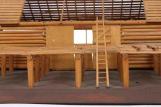24
PIONEER LOG BARNEvery settler's farm had to have a barn to shelter animals, store hay and grain and store equipment. It is a testimony to the skill of the barn raiser that many of these structures are still in use today. The barn in the U.E.L. group represents two structures 20 feet by 30 feet connected by logs. In the book "History of Wood" the construction method is given. "The first round of logs had saddle and rider corners. All the other corners were notched. The rafters were poles of spruce or cedar about 5 in. in diameter, framed at the butts to fit notches made 3 ft. apart in the plates, and projecting to support the caves. The tops of the rafters were halved and pinned or mitred and nailed. The gable ends were generally closed with 1 in. boards.
The roof was made of strips of cedar laid on the rafters and placed lengthwise of the barn about 3 ft. apart. These strips were covered with shooks of split cedar or pine, the second row overlapping the first, and so on. Both the strips and shooks were fastened with wooden pins. Poles or fence rails were laid on the ground in the mows to keep the hay and grain from moulding. Sleepers on the ground or on sills supported by the 20 ft. by 30 ft threshing floor where horses, driven round in circles, tramped out the grain to be stored in bins built along one side. Large openings for unloading hay or grain into the mows were made by cutting out, about 4 ft from the floor, five or six logs. The front of the barn was closed in with a centre double 12 ft. door and 1 in. boards; the back with 1 in. boards and a smaller door. Some pioneers built a platform at the back of the barn on which to put the straw stack. This conserved the straw and sheltered the livestock. The platform was of the same area as the barn and was supported by rows of posts set in the ground and standing 6 ft above it. Beams are laid into a hollowed place in the posts and sufficient small poles or fence rails were laid on the beams to prevent the straw from falling through. To feed the stock, straw was cut from the stack with a straw knife and pitch-forked to the ground. Without a platform more straw was tramped down than eaten and often the stack was undermined and fell, killing or maiming some of the stock".
